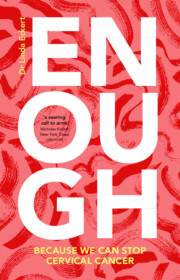Book contents
- Enough
- Reviews
- Enough
- Copyright page
- Dedication
- Contents
- Figures
- The Calling
- Part One A Preventable Cancer
- Part Two The Science behind Cervical Cancer
- Part Three The Prevention Problem
- 8 The Deadly Link between Inequality and Cervical Cancer
- 9 Losing the Life Lottery because of Where You Are Born
- 10 Sex, Lies, and Logistics: Obstacles to Vaccination beyond the Marketplace
- 11 Putting Out the Fires: Obstacles to Screening
- 12 “Dying Inside”: Obstacles to Treatment – and the Catastrophic Consequences
- 13 What Money Cannot Buy
- Part Four Getting to Enough
- Acknowledgments
- Reader Resources
- References
- Index
11 - Putting Out the Fires: Obstacles to Screening
from Part Three - The Prevention Problem
Published online by Cambridge University Press: 11 January 2024
- Enough
- Reviews
- Enough
- Copyright page
- Dedication
- Contents
- Figures
- The Calling
- Part One A Preventable Cancer
- Part Two The Science behind Cervical Cancer
- Part Three The Prevention Problem
- 8 The Deadly Link between Inequality and Cervical Cancer
- 9 Losing the Life Lottery because of Where You Are Born
- 10 Sex, Lies, and Logistics: Obstacles to Vaccination beyond the Marketplace
- 11 Putting Out the Fires: Obstacles to Screening
- 12 “Dying Inside”: Obstacles to Treatment – and the Catastrophic Consequences
- 13 What Money Cannot Buy
- Part Four Getting to Enough
- Acknowledgments
- Reader Resources
- References
- Index
Summary
If cervical cancer ravages a woman’s body like fire, then screening acts like a smoke alarm – detecting and even stopping that fire before it starts. Cervical screening tests also save hundreds of thousands of lives every year, are generally more affordable, and target a much greater age range than HPV vaccination. Still, limited access to comprehensive screening and follow-up leaves women across the world vulnerable to being burned by cervical cancer. In Africa, India, and parts of Asia and South America, less than 10 percent of women receive any screening at all. Higher-income countries, where cervical screening is widely available, face innumerable obstacles to increased participation. Screening is available in name only in many U.S. states, which limit eligibility for public health insurance or withdraw funding for low-cost clinics. In higher-income countries, non-White, immigrant, or low-income women typically receive less screening. Researchers attribute low uptake to racial biases, geographic challenges, medical illiteracy, and cultural irrelevancy. But as long as citizens tolerate inequity, thousands of persons with cervixes will forgo lifesaving screening measures.
Keywords
- Type
- Chapter
- Information
- EnoughBecause We Can Stop Cervical Cancer, pp. 143 - 175Publisher: Cambridge University PressPrint publication year: 2024

